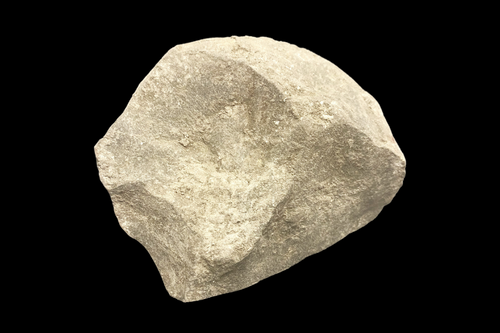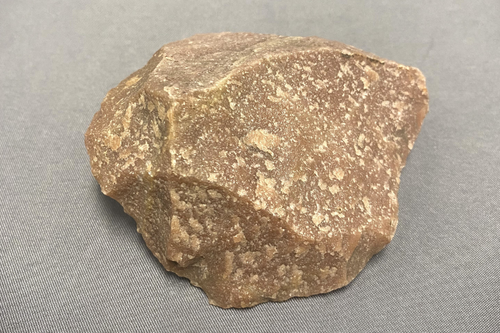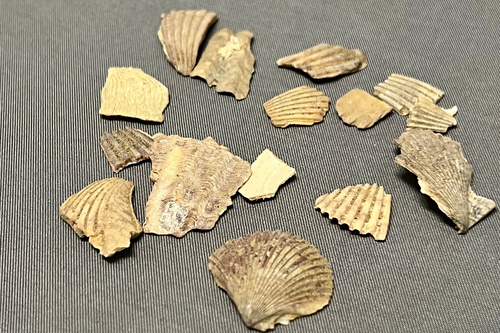
New Acquisitions: SDAC 753
Take a behind-the-scenes peak at our most recently acquired collections in our virtual exhibit New Acquisitions. To accompany this exhibit, each month the SDAC social media and collections blog New Acquisitions: A Closer Look will further examine the collections that are being curated, the research value they provide, and the importance of archaeology in San Diego County.
The San Diego Archaeological Center houses many prehistoric and historic collections from San Diego County and adjacent regions. The Center is equipped with over 5,000 square feet of vault space that provides long-term curation and care for a wide range of archaeological materials, including artifacts, ecofacts, maps, photographs, and site records. Partnering with local colleges and universities provides a setting for volunteers and students interested in archaeology to gain hands-on experience working with archaeological collections.
How Does the SDAC Acquire New Collections?
Most of the collections that are curated at the Center come to us from Cultural Resource Management (CRM) firms. These CRM firms work with developers and homeowners from around the county to make sure that construction is done using ethical and sustainable methods and that archaeological sites are protected and documented. Once their work is complete, CRM firms transfer the titles of the collections to the Center for their long-term preservation and care.
What is in a Collection?
New collections delivered to the Center have many parts. They must contain a site report, master catalog of curated objects, information about inadvertent discoveries, and, often, other supplemental documentation such as field notes, maps, and photographs.
SDAC 753 – Delivered August 16th, 2022
Project Name: Underground Utility District Project, City of San Diego, California
Site(s): P-37-040239 (Isolate)
USGS Quad Location: Point Loma 7.5’
Year of Excavation: 2020-2022
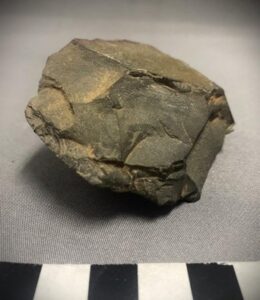
Material Class: Chipped Stone
Object Type: Scraper
Material: Volcanic
Quantity: 1
Weight: 124 grams
The new acquisition SDAC 753 came into the Center August 2022. This project was contracted by the City of San Diego to install underground utilities near what we now call Old Town, San Diego. The material collected was a Chipped Stone Core (Scraper), a prehistoric tool. This tool is an isolate find. In archaeology, the term isolate refers to one to three artifacts or cultural resources found disassociated from any known site. While they have no known context, they can still be significant and are sometimes collected from the field. After further evaluation, it was determined that the other isolates, historic items, found during the project were ineligible for significance under CEQA laws.
CEQA is an important law in California, requiring that all private and public activities be evaluated for the potential to impact the environment, including effects to historical and cultural resources. It defines historical resources as “any object, building, structure, site, area, or place, which is historically significant in the architectural, engineering, scientific, economic, agricultural, educational, social, political, military, or cultural annals of California” (Division I, Public Resources Code, Section 5021.1(b) This law helps to protect cultural resources in San Diego County by requiring mitigation efforts on construction or earth disturbing projects in the state.
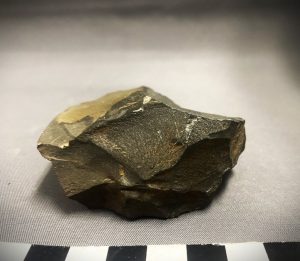
Material Class: Chipped Stone
Object Type: Scraper
Material: Volcanic
Quantity: 1
Weight: 124 grams
The work on the project consisted of almost 4,000 linear feet of trenches. Developers and CRM (Archaeologists) must identify the area of potential effects or APE before any trenching is to begin. By doing so, they can map out the project area and set up monitoring efforts. Archaeologists and Native American monitors worked on this project 109 days during “earth moving” activities. One site and five isolate finds were recovered by archaeologists during this process.
The one site that was identified during the project, SDI-23089, consisted of silty loam soils mixed with a historic trash deposit which could not be associated with a specific residence “and represented common household trash items from the early to mid-twentieth century.” Artifacts recovered were not found to be significant under CEQA so nothing was collected from this site. The artifacts were all bottles, three colorless glass, one aqua, one light green, and one cobalt blue. They were all deaccessioned once the evaluation deemed them insignificant. One historic structure was located within the project area, but it was not impacted by any of the work.
The one isolate that was collected and curated at the San Diego Archaeological Center for long term preservation and stewardship is this core scraper tool. This chipped stone tool is made of volcanic material and was likely used for many purposes throughout its life.
To learn more about this collection or if you have any questions regarding the acquisitions at the Center, please email collections@sandiegoarchaeology.org.
Come back next month as we take a closer look at SDAC 754!
By Jessica McPheters, Collections Manager
Reference
The following report was used for the analysis of this collection:
Montifolca, K., Pham, A. and Comeau, B. (July 2022) CULTURAL RESOURCES MONITORING REPORT FOR THE SAN DIEGO AVENUE (UU598) UNDERGROUND UTILITY DISTRICT PROJECT, CITY OF SAN DIEGO, SAN DIEGO COUNTY, CALIFORNIA. rep.


